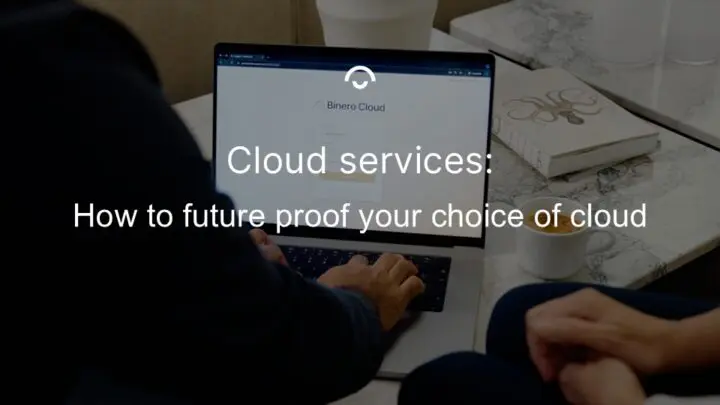Digital transformation opens up unique opportunities to reach more customers, offer more value and create growth, but it also opens up more vulnerabilities in IT security. Here you can learn more about how digital transformation affects your IT security and how you can protect yourself with tools such as data protection, encryption and compliance. Here are methods for digitising your business securely.
The rapid digital transformation is providing companies with more and more opportunities to deliver new customer experiences, gain competitive advantages and create growth. Digital transformation also involves extensive changes in how companies work with data, which in turn creates new vulnerabilities in IT security. It is therefore important for you, as a business undergoing digital transformation, to understand how this affects your IT security and how you can strengthen your data protection. Here's how you can achieve a secure digital transformation with the help of new technology, cyber security and compliance.
How digital transformation affects IT security
All change brings risks. Digital transformation means that organisations are introducing new technology, new ways of working and new workflows within a new infrastructure. While this opens up completely new opportunities to create value and improve efficiency, it also brings many new challenges in IT security. The biggest security challenges are:
- Increased vulnerability. With more digital systems and services, as well as larger amounts of data, the number of points that can be exploited for cyber attacks and intrusion attempts is also increasing. More tools and measures are needed to protect the digital infrastructure and all its data.
- Greater complexity. When new technologies and systems are introduced, and often integrated with older ones, networks become more difficult to monitor and keep secure.
- Third-party providers. The transition to digital processes often requires collaboration with external suppliers. For example, for cloud services. When responsibility for IT security is shared with others, it can be unclear who is protecting which part of the network. It can also be more difficult to gain insight into and control over risks when data is stored and managed by third parties.
- Remote disconnection. Digital transformation often means that users access networks and resources remotely. Examples include remote working and cloud services. If this happens without protective measures such as encryption and access control, or if users have insecure devices and weak passwords, vulnerability increases.
- Rapid changes. The digital transformation is happening at a much faster pace than previous technological changes. This can lead to security measures and knowledge lagging behind in the process.
- Internal problems. The transformation makes technology more accessible, which means that it becomes easier for the business side of the company to introduce and work with new technology without having to involve the IT department. This can mean that the organisation ends up with a larger proportion of shadow IT that is not covered by internal IT security. It can also result in security aspects being overlooked in favour of rapid introduction of new services and functions.
Secure your remote work and cloud services
There are several ways to address the security challenges of storing and managing data remotely when working remotely and using cloud services. Start by reviewing the types of data protection used by the cloud provider. The most common security measure for protecting cloud data is to encrypt it so that it is unusable to anyone who does not have access to the correct encryption key. Encryption should be used both when data is stored on servers (encryption at rest) and when you use it (encryption in motion). This ensures that it is protected from unauthorised access at all times. Role-based access control is an additional security measure that protects against unauthorised access. This means that each user role has limited data access that is controlled by what the role needs for its work.
One way to ensure that an external supplier maintains a high level of IT security is to ensure that they comply with security standards and regulations such as the General Data Protection Regulation (GDPR) and the ISO 27001data protection and security standard. These require security measures such as access control, encryption, incident analysis and management, data sovereignty and protection against physical threats.
In addition to ensuring that your external suppliers comply with regulations and maintain a high level of security, it is also important that you maintain a high level of cyber security when handling data remotely. For example, by using strong passwords, VPNs and secure connections, multi-factor authentication (MFA) and security solutions for endpoint protection. You can also segment your networks to restrict who has access to them.
Create an IT security strategy that integrates with your digital transformation
A common mistake in digital transformation is that IT security is an afterthought rather than being part of the entire development process. By making data security a fundamental part of digitalisation, it permeates the process and creates security awareness at all levels. From users to the IT department and management. This makes it easier for you to start from a Secure by Design model, where you build security into your systems and networks right from the start of the digital transformation.
Creating an IT security strategy is a multi-step process. Some important parts of the process are sometimes:
- Risk analysis. Identify and analyse the risks associated with digital transformation.
- Educate. Train everyone in the organisation about vulnerabilities, threats, security thinking and the procedures and tools you use to protect yourselves. Create an IT security culture where everyone takes responsibility.
- Follow standards and regulations. As mentioned above, GDPR and ISO 27001, but also regulations such as the currently relevant NIS2 directive. SOC 2 (System and Organisation Controls 2), NIST Cybersecurity Framework and PCI DSS (Payment Card Industry Data Security Standard) may be relevant, depending on whether you collaborate with global partners and customers or handle payment card information.
- Set requirements for third-party suppliers. Ensure that your third-party suppliers also comply with applicable standards and regulations. Review their security measures and references.
- Create a Zero Trust model where access to your data is only granted upon verification. Regardless of where in the network access occurs. We recommend working with role-based access control that limits who can access which data. This model is particularly relevant in today's IT environment, where users and resources often exist outside traditional network boundaries, such as in remote working and cloud services.
- Evaluate and improve your IT security work. Digital transformation means constant development, which is why your security work also needs to be reviewed and developed continuously. Stay up to date so that you are always one step ahead of attackers.
Collaborate with external expertise
Working with IT security during the digital transformation can seem challenging, but there is plenty of help available. By collaborating with third-party providers and security consultants, you can strengthen your security work and develop digitally in a safe way. You can get help with cloud security, security updates, vulnerability management and simulations that show where and how you can plug any security gaps.
External suppliers can also help with security measures and tools such as continuous monitoring and management of security incidents, as well as monitoring services that detect leaks of company information, DDoS protection against distributed overload attacks and third-party site backups. With the right support, you can achieve a fast and secure digital transformation without losing control of your IT security.
How Binero can help with your IT security and digital transformation
For us, IT security is central to everything we do and is also a fully integrated part of all our offerings. From cloud infrastructure and data management to monitoring and operations. All data stored with us is handled within Sweden and is subject to Swedish legislation and GDPR. In addition, our ISO 27001 certification guarantees that we meet the highest standards for information security.
We offer specialised IT security services as separate and tailor-made solutions for our customers. This enables us to meet specific security needs and help our customers further strengthen their IT security. Our IT security services include assistance with:
- Security consulting and implementation of the right tools.
- Analysis of risks, potential shortcomings and areas for improvement.
- Network Operations Centre (NOC) that monitors your networks in real time.
- Each individual customer is protected by an AI-based firewall that learns and adapts to the customer's unique traffic patterns. This provides one of the best security protections against external attacks on the market, ensuring maximum availability and uptime for your critical services and systems.
- Antivirus solution and firewall service that protects against malware and unauthorised access in real time.
- Dark Web monitoring 24/7.
- Solutions for Cloud-2-Cloud, on-prem and off-site backup, locked backup environment and Third Site Back-up to protect your data and guarantee fast recovery in the event of data loss or system failure.
Contact us if you want to know more about IT security for your digital transformation!


